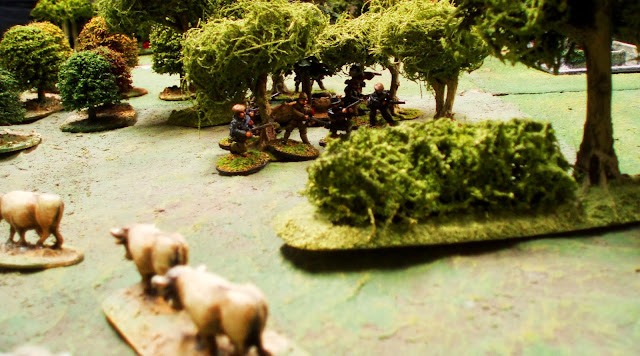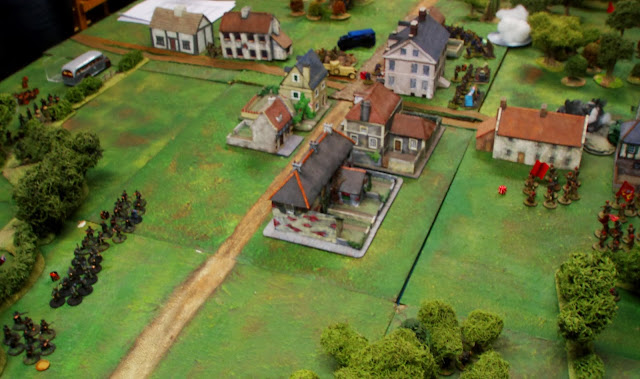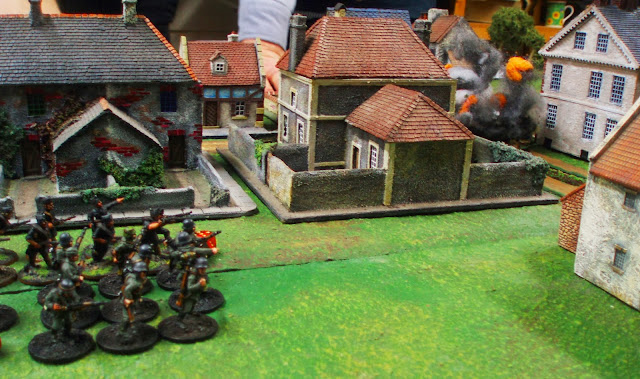1938 was a year of escalating
conflict in the north east of England ,
and that conflict was focussed mainly around the areas to the north and west of
Durham . The conflict had humble origins, beginning
with a short and inconclusive exchange of fire between some arms smugglers and
the police at a roadblock near Rothbury, but those first shots ignited a
terrible series of battles that became ever larger and more costly for all
involved.
 |
| https://www.northumberlandnationalpark.org.uk/places-to-visit/coquetdale/rothbury/ |
Three main factions emerged during
these early months of the war; the Communist forces commanded from the small
mining village of Chopwell, the British Union of Fascists (BUF) garrisoned at
Gateshead, and the private army of Lord John Lambton, the 5th Earl
of Durham. The so-called ‘Lambton’s
Hounds’
The Communists at Chopwell came
to prominence under the leadership of ‘Chief Comrade’ John Harding, a famously
hard-drinking farmer and Socialist.
After the dissolution of Parliament, Harding organised local Marxist sympathies
into a cohesive force around Chopwell and spent the early part of 1938 looting
banks, businesses, and local wealthy properties and families. The Communists called this the ‘great
redistribution’ and it gave them tremendous economic and political power during
the initial period of ‘phoney conflict’.
They used some of the money to provide social services to the local
population and set up community restaurants, civil defence volunteer
organisations, and collective farms. However, much of it was reserved for the
coming war effort, and their early attempts to acquire arms brought them into unproductive
contact with the Northumberland Freedom Fighters (involved in the incident at
Rothbury). The Communists attempted to
open a supply route to Russia
along the River Tyne. However, the
Royalist military to the north, and the BUF at Gateshead
successfully closed off this option.
Harding turned to the Comrades down in the Free City of Liverpool and
was able to establish a fairly stable supply corridor up through Alston. As the year progressed, the forces at
Chopwell were significantly bolstered with Russian materiel including advisors,
small arms, heavy guns, mortars, and even T26 tanks. By the end of 1938, the Chopwell militia were
as well supplied as any army in Britain
at the time.
The King and Prime Minister
Moseley were very concerned about the potential loss of the Durham coalfield and early in the war they despatched
a contingent of BUF troops under the command of Arthur Wendbury-Pace. These forces were drawn from Essex and Suffolk and were garrisoned in Gateshead, near the mouth
of the river Tyne . They were initially supplied from London by sea, but as the
year developed they were increasingly able to rely on local resources,
including recruits. Gateshead
had a large Jewish enclave, but also harboured an extreme right wing ‘Gateshead
German League’ who quickly allied with the BUF in return for a free hand in
dealing with what they perceived as the ‘Jewish problem’. This alliance had a significant effect on the
BUF in the north east. The link with the
authorities in London became weakened,
particularly as the fighting across London
severely reduced the supply shipments up to the north. The BUF began to receive ‘lend lease’
supplies from Germany
including Wermacht advisors, materiel, and armoured vehicles. Nazi advisors also provided military and
political training to the BUF Legions, forming them in to a highly effective
fighting force that rivalled the regular army of Lord Percy’s Tenantry to the
north of the Tyne .
The third protagonist force was
the private army of Lord John Lambton, the 5th Earl of Durham. Lord Lambton suspected that trouble was
brewing long before the political troubles and the dissolution of Parliament,
and he used a sizeable part of his fortune to purchase a significant stock of
French Great War army surplus kit. His
troops were drawn mainly from his estates and took to the field in the French
blue with yellow painted helmets of his livery.
These eager amateurs were supplemented with paid mercenaries that
provided training and a much needed backbone in the field. Lambton also maintained a fleet of armour
Rolls Royce cars which were his pride and joy throughout the war. It was said that he would forgive his
commanders for losing a battle, but not for losing a Rolls Royce.
By mid-1938, the dominance of the
Chopwell Communist forces, in terms of size and supply, forced the BUF and Lord
Lambton into an uneasy ‘royalist alliance’.
They were united by their common opposition to the ‘Red menace’, support
for the King, and little else. Despite
this, they fought alongside each other in a series of escalating battles
throughout the year. These culminated in
the major action at High Hold, and the subsequent engagements during the rout. After a series of planning meetings, the
royalist alliance gathered at Ousten, Urpeth, Pelton, and Pelton Fell with the
intention of invading the Communist heartland to break their burgeoning power. Lord Percy also sent Tenentry support from
north of the Tyne , to try and bolster the
royalist attack and hopefully end the thorn in his side that was the
Communists. He had far greater troubles
dealing with the Northumberland Freedom Fighters, Ashington Socialist rebels and
Scottish nationalist border incursions and was happy to supply aid to try and
nip the Communist threat in the bud. The
assembled forces moved west into the outer Communist defences at High Hold on
the morning of 30th August 1938. Their
initial scouting, especially by motorised BUF patrols, has shown the Red
militia in the area to be very poor quality.
The royalist commanders were also astonished at the apparent lack of
fortifications or even basic defences in or around High Hold, which in part was
the reason for concentrating their attack in that area.
The central defence council in Chopwell
were labouring under the assumption that High Hold was a fortified in
accordance with their orders and was a well defended outpost beyond their main
garrison at Stanley . They had invested a great deal of resources
and placed a series of what they assumed were competent commanders in that area
with the expressed purpose of defending it strongly against a much anticipated
attack from Gateshead. Testimonies from
after the war suggest that the commanders sent to the area were incompetent and
complacent and failed to undertake the work they were assigned to. Joseph Cardwell, in his excellent book The Chopwell Communists, suggests that
the deficiencies were more to do with corruption among the administrative and
logistics brigades, and that the resources intended for the fortification of
High Hold never arrived. In any case,
High Hold was a poorly fortified position but still well defended with a large
force of militia. To the royalists’
misfortune, the night before the attack, a visiting force of the Socialist
Boiler Maker Union Federation of the Working Men were camped in the area. They had concluded unsuccessful negotiations
concerning the possible alliance with Chopwell and were intending to return to Newcastle the following
morning. They would take part in the
battle in aid of their Socialist brothers, and later survivors said that this
was simply as they had nowhere to go except through the royalist lines.
The Battle of High Hold was the
largest engagement of the war so far and was undoubtedly a bloody affair. Full details of the action can be read
elsewhere, but the outcome was a significant victory for the Communists. The royalist attack was halted at the outskirts
of the village, although a concentration of Tenantry armour on the northern
flank almost broke through. The
Communist immediately pursued, initially as an ill-disciplined rush and quickly
as an organised counter attack and the royalist retreat turned into rout. Lord Percy’s Tenantry fled north and made it
to safety across Wylam
Bridge Durham .
This pursuit was halted at the two day battle at The Duke of Wellington
public house. Despite the Communist
armour attacking in force, a ragtag collection of royalists commanded by
General Morley-Lustworth, who had been badly injured the day before, was able
to hold the crossroads and deny the Reds access into Durham .
The Anglican League, ostensibly in control of Durham at this period of the war, offered no
help in defending this ground on their border.
Subsequent to the action, Lord Lambton issued various scathing articles
and communications concerning the battle.
Privately he was most furious with his own commanders who he felt had
wasted the lives of their men defending Anglican territory.
At the end of the fighting the
borders were restored, and the positions remained largely unchanged. Many of the ‘old timers’ who’d fought in the Flanders
trenches remarked how the fighting over the year had been just like the Western
Front; a lot of men lost for no gain.
The most significant outcome for the battles over the year, and in
particular the massive effort from all sides around the High Hold campaign, was
to deplete the supplies and reserves of the Communists, the BUF, and Lord
Lambton. Ammunition in particular was
now extremely scarce, and it would remain so until well into 1939.


































































